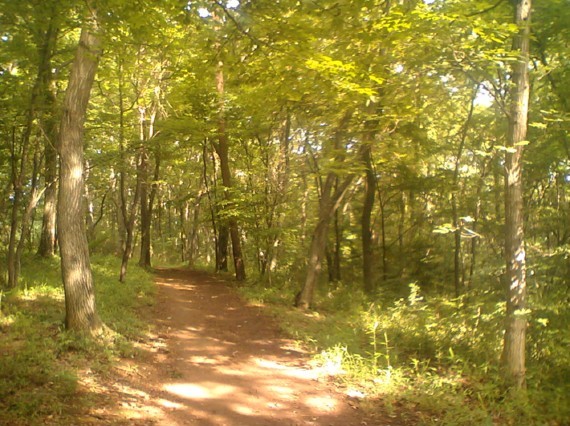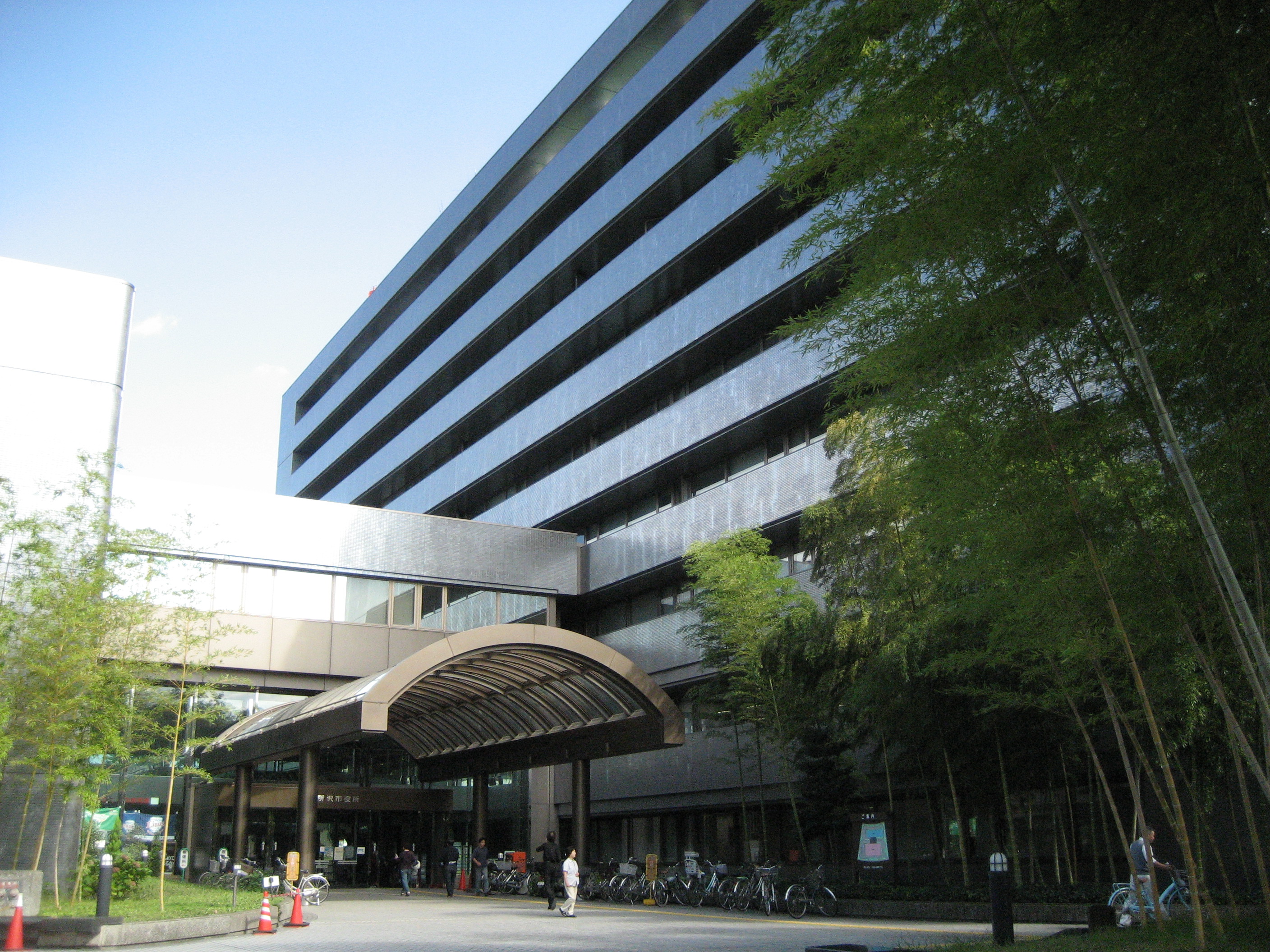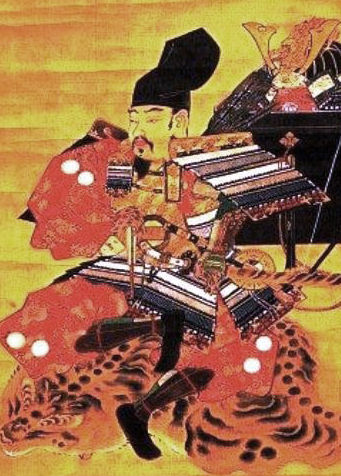|
Hachikokuyama
is a ridge and park in Higashimurayama, Tokyo along its border with Tokorozawa, Saitama. Its name translates literally into English as "Eight Country Mountain" since in times past, one could view the eight surrounding provinces surrounding Musashi Province from its top. In Japanese it is known as a ryokuchi (緑地) instead of a park. Ryokuchi literally means "green land" and denotes land used more as a natural setting instead of a typical park. The park lies upon a low rising ridge rising about 15 to 20 meters above the surrounding plain. The highest elevation is about 100 meters above sea level. Measured from north to south, the park is from 100 to 300 meters, the park having an uneven size. From east to west the park is about 1.5 kilometers. The trail that runs the length of the ridge top is about 2.0 kilometers and branches into many secondary trails. The total size of the park of is about 39 hectares or about 96 acres. Historical significance The park contains an archaeo ... [...More Info...] [...Related Items...] OR: [Wikipedia] [Google] [Baidu] |
Tokorozawa, Saitama
is a city located in Saitama Prefecture, Japan. , the city had an estimated population of 344,194 in 163,675 households and a population density of 4800 persons per km². The total area of the city is . Geography Tokorozawa is located in the central part of the Musashino Terrace in southern Saitama, about 30 km west of central Tokyo. Tokorozawa can be considered part of the greater Tokyo area; its proximity to the latter and lower housing costs make it a popular bedroom community. The Higashikawa and Yanasegawa rivers that flow from the Sayama Hills flow to the eastern part of the city, and finally reach the Arakawa River. The Yamaguchi Reservoir (commonly known as Lake Sayama) is mostly located within city boundaries; Lake Tama also touches the south-western part of the city. The area around Tokorozawa Station's west exit is built up as a shopping district with several department stores. Prope Street is a popular shopping arcade. Surrounding municipalities * Saitama Pr ... [...More Info...] [...Related Items...] OR: [Wikipedia] [Google] [Baidu] |
Higashimurayama, Tokyo
is a city located in the western portion of Tokyo Metropolis, Japan. , the city had an estimated population of 148,275, and a population density of 8700 persons per km2. The total area of the city is . Geography Higashimurayama is located on the eastern edge of the Sayama Hills, almost in the center of the Musashino Terrace. Most of the city area is flat, except for the northwestern hills. Surrounding municipalities Tokyo Metropolis *Higashikurume * Kiyose * Higashiyamato *Kodaira Saitama Prefecture *Tokorozawa Climate Higashimurayama has a Humid subtropical climate (Köppen ''Cfa'') characterized by warm summers and cool winters with light to no snowfall. The average annual temperature in Higashimurayama is 14.0 °C. The average annual rainfall is 1647 mm with September as the wettest month. The temperatures are highest on average in August, at around 25.7 °C, and lowest in January, at around 2.3 °C. Demographics Per Japanese census data, the population ... [...More Info...] [...Related Items...] OR: [Wikipedia] [Google] [Baidu] |
Mount Fuji
, or Fugaku, located on the island of Honshū, is the highest mountain in Japan, with a summit elevation of . It is the second-highest volcano located on an island in Asia (after Mount Kerinci on the island of Sumatra), and seventh-highest peak of an island on Earth. Mount Fuji is an active stratovolcano that last erupted from 1707 to 1708. The mountain is located about southwest of Tokyo and is visible from there on clear days. Mount Fuji's exceptionally symmetrical cone, which is covered in snow for about five months of the year, is commonly used as a cultural icon of Japan and it is frequently depicted in art and photography, as well as visited by sightseers and climbers. Mount Fuji is one of Japan's along with Mount Tate and Mount Haku. It is a Special Place of Scenic Beauty and one of Japan's Historic Sites. [...More Info...] [...Related Items...] OR: [Wikipedia] [Google] [Baidu] |
Fujizuka
are small mounds, commonly found in and around Tokyo, which represent Mount Fuji. During the Edo period (1603–1868), a cult arose around the mountain, one of whose major devotional rites was to climb to the peak. Pilgrims who were unable through age, infirmity or gender to climb Mount Fuji would ascend one of these surrogates instead. They were usually around ten feet high, and replicate the 10 stations on Fuji itself, from the foot of the mountain to the summit. Some were also situated so as to provide pleasant views of their surrounding area, such as the ''Moto-Fuji'' at Meguro. Although they are not included among the objects that make up the Cultural World Heritage Site, there are many Fujizuka that have been designated as Cultural Properties by the national government of Japan or by local governments. Famous Fujizuka within the precincts of Tokyo include the Shitaya-sakamoto Fuji (within the grounds of the Onoterusaki shrine), the Nagasaki Fuji (beside the main shrine buil ... [...More Info...] [...Related Items...] OR: [Wikipedia] [Google] [Baidu] |
Kofun
are megalithic tombs or tumuli in Northeast Asia. ''Kofun'' were mainly constructed in the Japanese archipelago between the middle of the 3rd century to the early 7th century CE.岡田裕之「前方後円墳」『日本古代史大辞典』大和書房、2006年。 The term is the origin of the name of the Kofun period, which indicates the middle 3rd century to early–middle 6th century. Many ''kofun'' have distinctive keyhole-shaped mounds (). The Mozu- Furuichi kofungun or tumulus clusters were inscribed on the UNESCO World Heritage List in 2019, while Ishibutai Kofun is one of a number in Asuka-Fujiwara residing on the Tentative List. Overview The ''kofun tumuli'' have assumed various shapes throughout history. The most common type of ''kofun'' is known as a , which is shaped like a keyhole, having one square end and one circular end, when viewed from above. There are also circular-type (), "two conjoined rectangles" typed (), and square-type () kofun. Orientation ... [...More Info...] [...Related Items...] OR: [Wikipedia] [Google] [Baidu] |
Kamakura Shogunate
The was the feudal military government of Japan during the Kamakura period from 1185 to 1333. Nussbaum, Louis-Frédéric. (2005)"''Kamakura-jidai''"in ''Japan Encyclopedia'', p. 459. The Kamakura shogunate was established by Minamoto no Yoritomo after victory in the Genpei War and appointing himself as ''shōgun''. Yoritomo governed Japan as military dictator from the eastern city of Kamakura with the emperor of Japan and his Imperial Court in the official capital city of Heian-kyō (Kyoto) as figureheads. The Kamakura ''shōguns'' were members of the Minamoto clan until 1226, the Fujiwara clan until 1252, and the last six were minor princes of the imperial family.Nussbaum"Minamoto"at pp. 632–633. The Hōjō clan were the ''de facto'' rulers of Japan as ''shikken'' (regent) of the ''shōgun'' from 1203.Nussbaum"Fujiwara"at pp. 200–201. The Kamakura shogunate saw the Jōkyū War in 1221 and the Mongol invasions of Japan under Kublai Khan in 1274 and 1281. The Kamaku ... [...More Info...] [...Related Items...] OR: [Wikipedia] [Google] [Baidu] |
Nitta Yoshisada
was a samurai lord of the Nanboku-chō period Japan. He was the head of the Nitta clan in the early fourteenth century, and supported the Southern Court of Emperor Go-Daigo in the Nanboku-chō period. He famously marched on Kamakura, besieging and capturing it from the Hōjō clan in 1333. Later he fought the Takauji brothers on the Emperor's behalf in a see-saw campaign which saw the capital change hands several times. After a peaceful compromise was agreed, Yoshisada was entrusted with two royal princes. At the siege of Kanegasaki (1337), both princes were killed, along with Yoshisada's son, although Yoshisada was able to escape. He committed seppuku when his horse was killed at the siege of Kuromaru. Early life Yoshisada was born in 1301, the eldest son of Nitta Tomouji. He succeeded his father and became the lord of Nitta Manor in Kōzuke Province in 1317. At this time, he also became the head of the Nitta clan. Yoshisada courted a daughter of a court noble, Kōtō-Naish ... [...More Info...] [...Related Items...] OR: [Wikipedia] [Google] [Baidu] |
Tōsandō
is a Japanese geographical term. It means both an ancient division of the country and the main road running through it. It is part of the ''Gokishichidō'' system. It was situated along the central mountains of northern Honshu, specifically the Tōhoku region. This term also refers to a series of roads that connected the of each of the provinces that made up the region. The Tōsandō region encompasses eight ancient provinces. *Ōmi Province *Mino Province *Hida Province *Shinano Province *Kōzuke Province *Shimotsuke Province *Mutsu Province *Dewa Province After 711 AD, Tōsandō was understood to include the Musashi province. Nussbaum, Louis-Frédéric. (2005). "''Tōsandō''" in . See also * Comparison of past and present administrative divisions of Japan * Nakasendō (post-Sekigahara Tōsandō) * Sanriku, neighbouring region Notes References * Nussbaum, Louis-Frédéric and Käthe Roth. (2005) ''Japan encyclopedia.''Cambridge: Harvard University Press. OCLC 58053 ... [...More Info...] [...Related Items...] OR: [Wikipedia] [Google] [Baidu] |
Sue Ware
was a blue-gray form of stoneware pottery fired at high temperature, which was produced in Japan and southern Korea during the Kofun, Nara, and Heian periods of Japanese history. It was initially used for funerary and ritual objects, and originated from Korea to Kyūshū. Although the roots of Sueki reach back to ancient China, its direct precursor is the grayware of the Three Kingdoms of Korea. History The term ''Sue'' was coined in the 1930s by the archaeologist Shuichi Goto ( :ja:後藤守一) from a reference to vessels mentioned in the 8th century Japanese classical poetry anthology ''Man'yōshū''. Previous to this, the terms or ''Chosen doki'' were in more common use. Sue pottery is believed to have originated in the 5th or 6th century in the Kaya region of southern Korea, and was brought to Japan by immigrant craftsmen. It was contemporary with the native Japanese Haji pottery, which was more porous and reddish in color. Sue ware was made from coils of clay, beaten ... [...More Info...] [...Related Items...] OR: [Wikipedia] [Google] [Baidu] |
Jōmon Period
The is the time in Japanese history, traditionally dated between 6,000–300 BCE, during which Japan was inhabited by a diverse hunter-gatherer and early agriculturalist population united through a common Jōmon culture, which reached a considerable degree of sedentism and cultural complexity. The name "cord-marked" was first applied by the American zoologist and orientalist Edward S. Morse, who discovered sherds of pottery in 1877 and subsequently translated it into Japanese as ''Jōmon''.Mason, 14 The pottery style characteristic of the first phases of Jōmon culture was decorated by impressing cords into the surface of wet clay and is generally accepted to be among the oldest in the world. The Jōmon period was rich in tools and jewelry made from bone, stone, shell and antler; pottery figurines and vessels; and lacquerware.Imamura, K. (1996) ''Prehistoric Japan: New Perspectives on Insular East Asia''. Honolulu: University of Hawaii Press It is often compared to pre-C ... [...More Info...] [...Related Items...] OR: [Wikipedia] [Google] [Baidu] |






_MET_2015_300_259_Burke_website.jpg)
